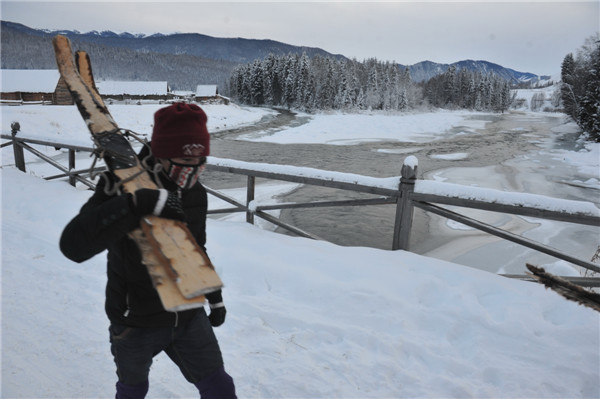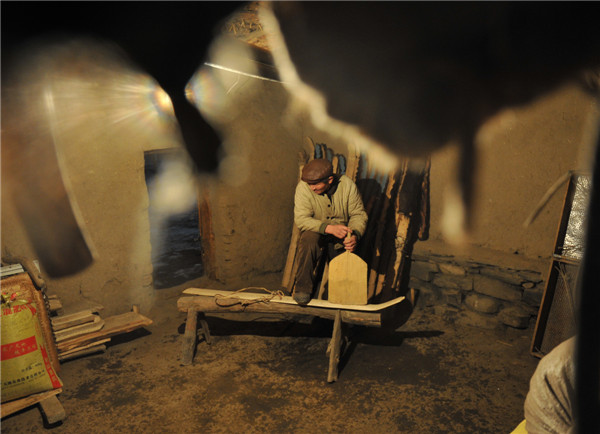 |
|
A man in Hemu carries his skis. Experts say the primitive people who lived in the area long ago were probably the first humans to master the art of skiing. Photos by Yao Tong / for China Daily |
Unlike the Tuvans in Hemu, the residents of Handerte Mongolian township, where the famous rock painting was discovered in 2005, like to refer themselves as Wulianghai, a name given to the Tuvan during the Qing Dynasty (1644-1911).
The painting on the roof of the cave depicts human figures on skis, bending their knees as they travel alongside animals, including deer and moose.
An iron fence was erected at the entrance of the stone cave and a small museum was built. Later, a statue of a skiing Wulianghai man wearing traditional Mongolian costume was erected in the center of the township's small square. Since local archeologists declared Altay the birthplace of skiing in 2006, a fur-ski contest has been held every year.
Zhamuke and his friends were playing around the base of the statue on a sunny afternoon. He said everyone in the village knows how to ski. "I love skiing off the edges of rocks because it feels like flying," said the 10-year-old, who has been learning the skill since age 5, waving his arms in the air like wings.
Aolongbayier, deputy head of the township, said, "Although hunting moose is banned, the villagers in the mountains still use fur skis to hunt wild boar in the winter.The snow slows the animals down and because the Wulianghais are fast skiers, the boar become relatively easy to catch."
The 32-year-old said he's proud that a tradition that originated close to his hometown, possibly more than 12,000 years ago, remains practical and popular among local people. The 4,100 residents of the 30 households still make new skis every year, he added.
 |
|
Ahelibek Ulalib is one of just a few people who can make fur skis, a skill passed down in his family. |
"Skiing has been closely related to hunting for centuries. The area around Altay has always had plenty of snow and animals in the forest, so the materials used for making fur skis have always been accessible. Also, the pattern and paint used, and tools made of stones discovered in nearby caves, all suggest that the painting could have been made by the primitive people who used the cave as shelter in the late Paleolithic Age," said Wang Bo, an archaeologist from Xinjiang Museum who has examined the painting.
Although the world's oldest ski, thought to be around 8,000 years old, was found in Russia, the Kazaks who live in the area also know how to make and use fur skis.
Ahelibek Ulalibek, from Nuogaite village near Altay, was unaware of the history of fur skis, but he knows how to make them - the skill has been passed down in his family from generation to generation.
The 54-year-old, who has been making skis for more than 10 years, made 50 pairs in 2012 and sold 30 of them last year. His customers included villagers who still hunt and local ski resorts which use them to attract visitors. "I also sold a pair to a Russian," he said proudly. When we met, he was busy making more skis in response to a large order from a ski resort.
